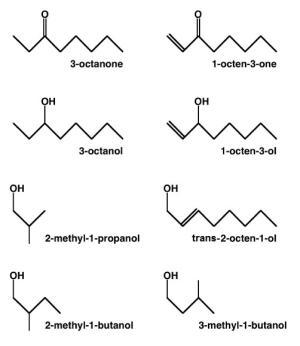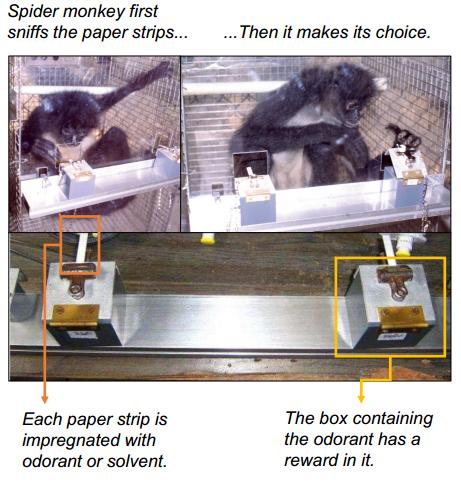The animals
In the study, three black-handed spider monkeys were used (Ateles geoffroyi). The animals were born in captivity and were kept at the Field Station UMA Dońa Hilda Įvila de O“Farrill, managed by the Universidad Veracruzana, near Catemaco, Veracruz, Mexico.

The odorants

The behavioral test

The spider monkeys were tested using a food-rewarded instrumental conditioning paradigm. In order to do this, a test apparatus like the one in the figure (to the left) was used. Each PVC box contained a metal clip, where a paper strip was attached. The paper strips were impregnated with 20µl of an odorant used as rewarded stimulus (S+) or with 20 µl of the near-odorless solvent (DEP) used as unrewarded stimulus (S−). The box where the rewarded stimulus was attached, contained a food reward, while the the box with the odorless paper strip did not contain the food reward.
When presented with the apparatus, the individual sniffed both paper strips for as long as it liked and then decided to open one of the boxes. The animal retrieved a food reward in case of a correct choice, or found the box empty in case of an incorrect choice. These presentations were given in three blocks of 10 trials (i.e. three sessions) per day. Each one of the two boxes of the apparatus was baited with a food reward in five of the 10 trials that comprised a session. The order of the rewarded sides was randomized with the only condition being that the same box would not be baited more than three times in a row.
The behavioral testing followed these steps:
1- Testing started at a 100-fold dilution of a given odorant. This dilution was presented on three subsequent days (i.e. for nine sessions comprising a total of 90 trials);
2- After this, the odorant is diluted by 10-fold (e.g. 100 to 1000) and presented to the animals until they fail to discriminate between the odorized paper strip and the odorless one (not reaching 21 correct choices out of 30).
3- Every time an individual failed to discriminate a dilution step for the first time, the dilution would be presented for a second time (i.e. three more sessions).
4- In case of failure again, an intermediate dilution step (0.5 10-based logarithmic units between the lowest concentration that was detected and the first concentration that was not) for three sessions to determine the threshold value more exactly.
Responsible for this page:
Director of undergraduate studies Biology
Last updated:
06/25/17
